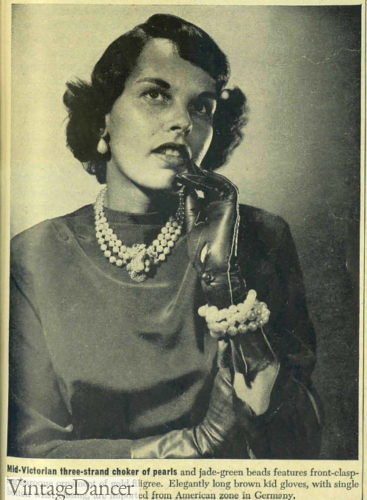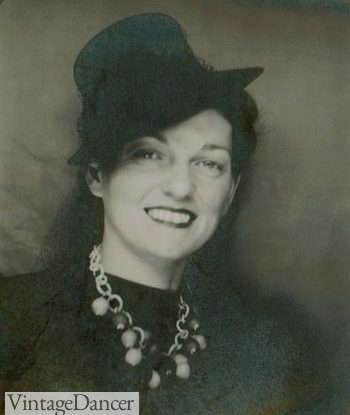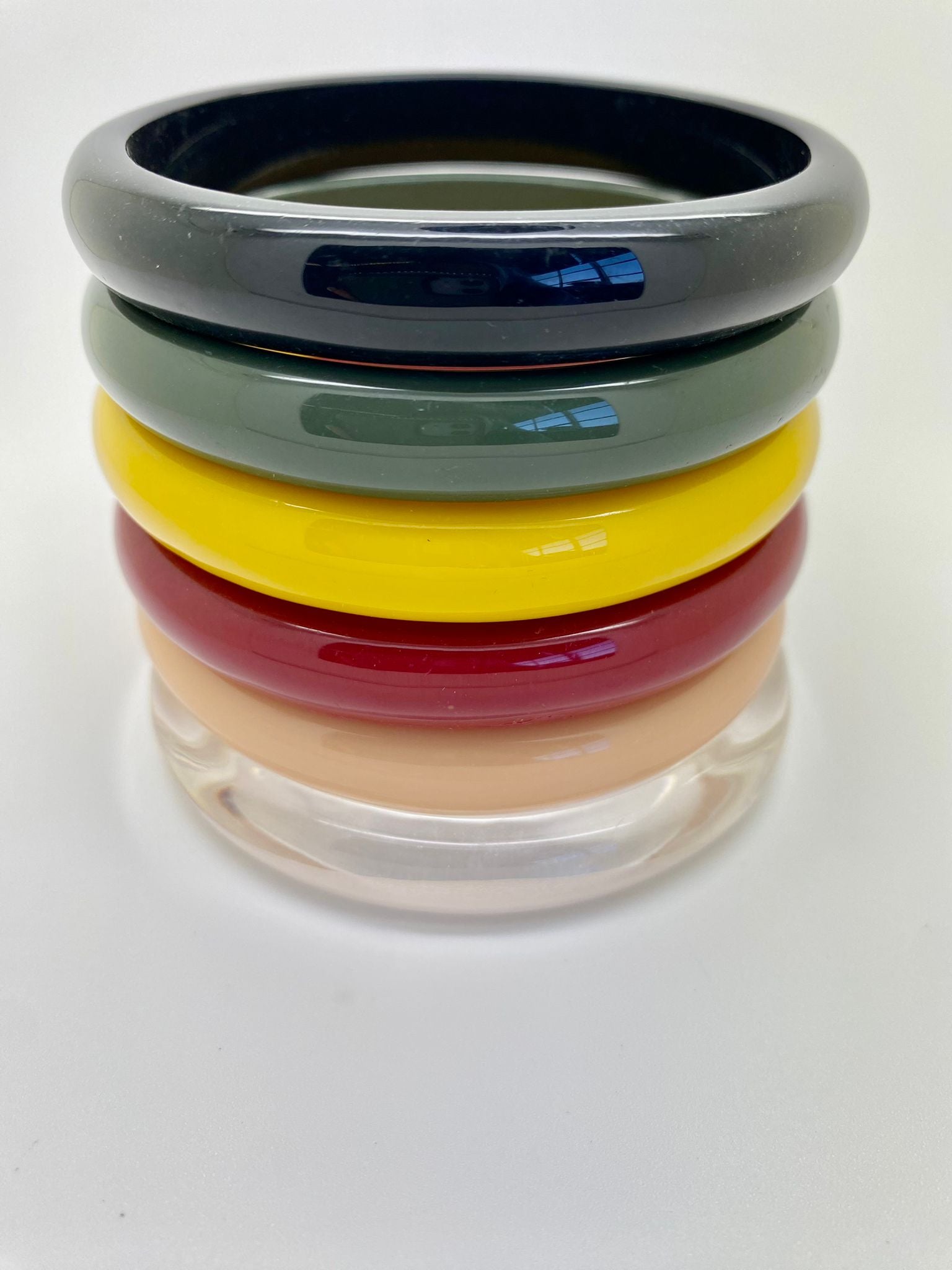Following on from vintage jewelry styles of the 1930s, this article shall examine popular 1940s jewelry styles and trends. In order to add that finishing touch to a 1940s inspired outfit, highlighted are some vintage reproduction jewelry styles available to buy today.
1940s Jewelry History
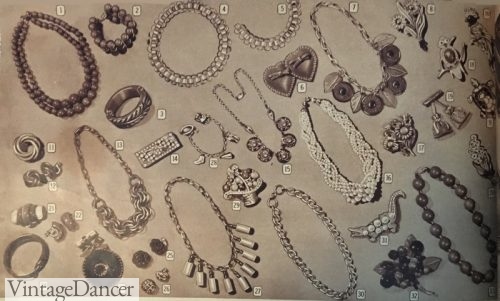
1948: Bead necklaces, bangles, novelty brooches, flowers themes, and charm bracelets provide a variety to 1940s jewelry
As the Great Depression was ending and a new war was looming, all of the fashion world turned back to home in America. Many fashion magazines were now in color, so clothing and jewelry were especially bright and cheerful, a necessary mood and morale enhancer during tough times.
Hollywood actresses graced the pages of magazine spreads wearing old and new designs in a vivid color palette, but they were not wearing high end pieces from France. Instead, they wore vintage Art Deco jewelry or cheaper costume jewelry designed in America.

1945 earrings
Putting cheaper (although still not affordable to many) jewelry on movie stars gave the illusion of richness but also attainability. A star’s familiar face was a piece of home. The jewelry designs were easily replicated into cheap costume jewelry sold at local five and dime shops. No longer was jewelry saved up for — it was now available in every price range.
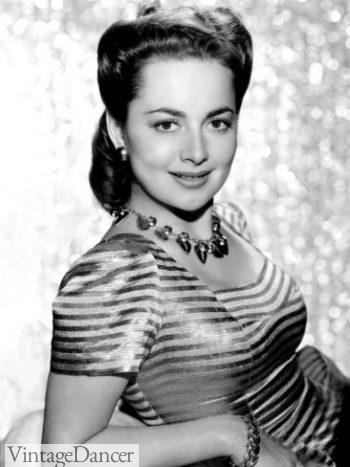
Olivia He Havilland adorned in a large statement necklace
Metal was in very short supply during the war. This made it difficult for jewelry to be made on a silver plate. Sterling silver had to be used instead. Other shortages included imported cultured pearls, Titanium, high grade imitation stones (from central Europe), and skilled staff. Most factories and skilled labor were repurposed into making detailed military equipment. New workers had to be trained. Immigrants from Eastern Europe who had previously been diminished to unskilled labor jobs were now able to put their jewelry design skills to use.
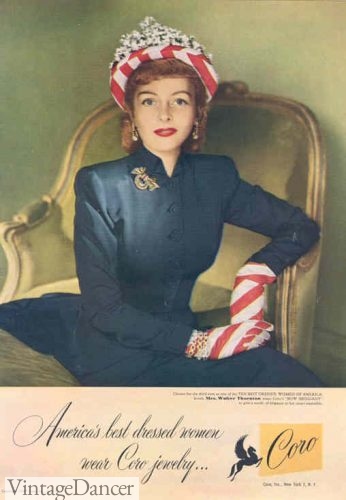
1947 Mrs. Thornton in a classy Coro brooch lapel pin
Set against plain and masculine clothing, 1940s jewelry was larger, more colorful, and more fun. Elegance was out, novelty was in. Large jewelry was used to decorate dresses, hats, belts, and shoes. Clips and pins were worn on hats. Belts were adored with sparkling buckles and brooches. Dress clips were worn in the center of a V or square neckline. Shoe clips jazzed up plain pumps. It was often the only feminine detail on a woman’s entire ensemble.
White metal and rhinestones provided the base for larger color gemstones to be featured. New, cheaper materials such as wood, shell, glass, plastic, and fabric were transformed into elegant works of art. Patriotic symbols, flowers, bows, and whimsical animals dominated most jewelry themes.
Studying 1940s jewelry requires a look at both the materials being used and the purpose.
1940s Jewelry Materials
“American women are crazy for jewelry.”
December 15, 1942, Colliers
Vermeil Gold
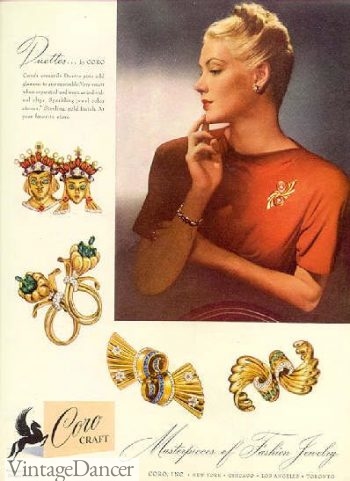
Vermeil, meaning gold plated, was the most common base for affordable costume jewelry in the 1940s
Vermeil is a base of silver which is then plated with gold, giving a warm golden finish. Due to austerity restrictions during this decade, vermeil became a popular choice for costume jewelry. The idea of vermeil was that it gave the appearance of being gold, when of course it was merely coated with a very thin layer of gold.
Designer Marcel Boucher created abstract animal figures combining gold vermeil and cut stones. While his designs are highly collectible, knock off costume jewelry embraced plenty of his aesthetic.
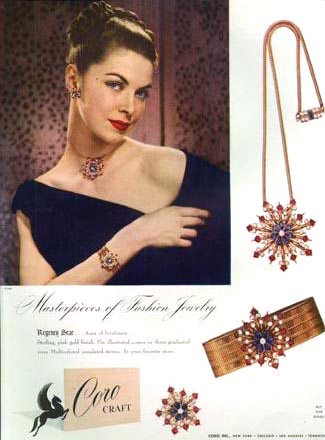
1945 Corocraft sunburst jewelry in gold
Bakelite Plastics
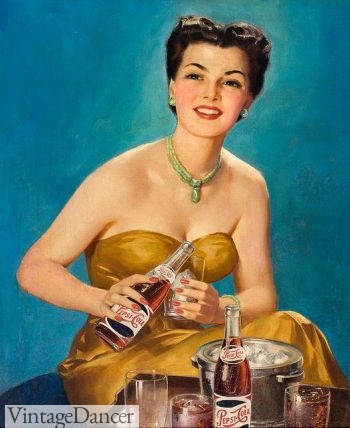
This Pepsi ad woman is wearing a green necklace, possibly made of Bakelite or Catalin plastic
Early plastics started to grow in popularity at the start of the 20th century. Celluloid – a plastic derived from plant cells, was used in jewelry production as early as the late 1800s. The most popular plastic of the period was Bakelite. Developed in 1907, the material became immensely popular in the 1930s and 1940s. The bright attractive colors coupled with the equally attractive low price point made Bakelite jewelry accessible to all.
Catalin, another early plastic, became equally popular during this time. Marbled effects and translucent hues produced in Catalin rivaled the shades available in Bakelite. Lucite was also common, becoming more popular into the 1950s.
Plastics were usually used to make brooches and statement necklaces. Many designed mixed plastic and wood or plastic and shell together. Over time, Bakelite blue turns black and white plastic turns yellow. It is rare to find 1940s Bakelite in the original red, white, and blue shades.
Shop 1940s Bakelite on Etsy.
Handmade Jewelry
People were encouraged to ‘Make do and Mend’ due to austerity restrictions. This attitude soon spread to clothing and accessories, with many garments being re-fashioned in order to get the most wear out of them.
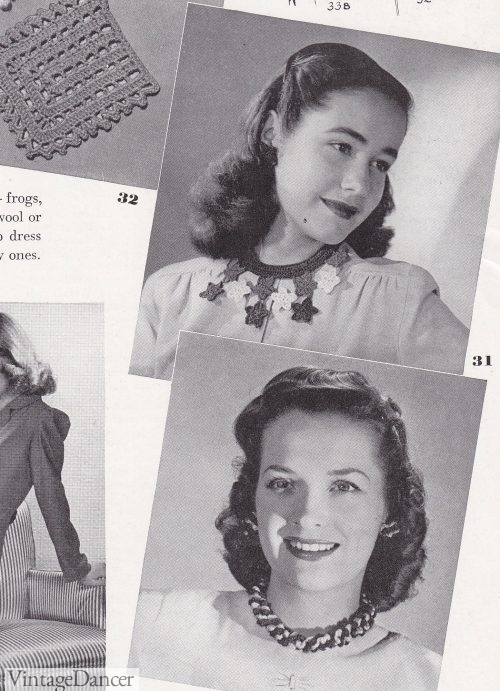
Women modeling crochet necklaces in ‘Make and Mend’, 1942
Felt flower brooches were a popular and relatively easy way to accessorize an outfit. The material itself cost little, and a batch could be sewn-up in an evening.
Make a 1940s felt flower brooch here.
Necklaces were being made from crochet. Detachable collars with delicate embroideries were also made. This was the decade of resourcefulness, and as such, many new ideas and styles emerged.
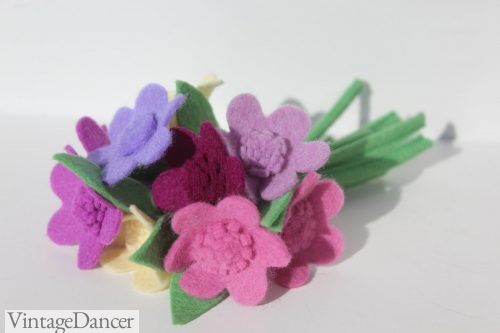
Dress up your lapels with this felt flower pin by 1940s Style For You. Shop felt floral brooches.
1940s Jewelry Styles
Bracelets and Bangles
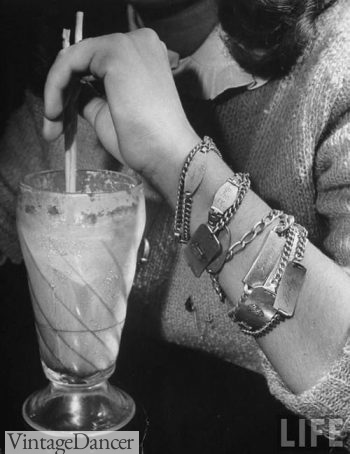
1944, a popular trend for teens was to wear one or many charm bracelets or ID bracelets
The two most popular styles of bracelets in the ’40s were identification bracelets and charm bracelets. ID bracelets were a thin metal chain with a flat metal rectangle or oval attached in the center. Both gold and silver were used, but a gold tone was more popular. The center plate would have the person’s name engraved on it, often in cursive-style writing.
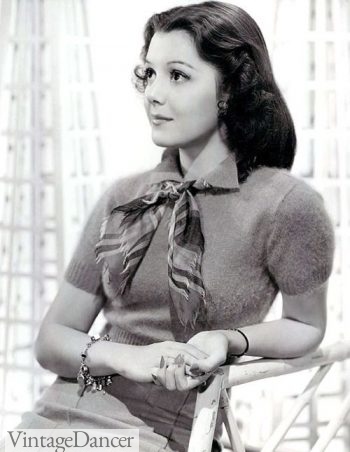
A charm bracelet is worn on her arm
Charm bracelets were a thin gold or silver chain, more often silver, with different charms attached at intervals – women and girls collected the charms to fill up their bracelets. They could be anything from flowers and animals to lucky horseshoes and clovers. Bells, hearts, and household items were also made into charms. Charms could be used to show off the personality and likes of the wearer.

1940 bracelets
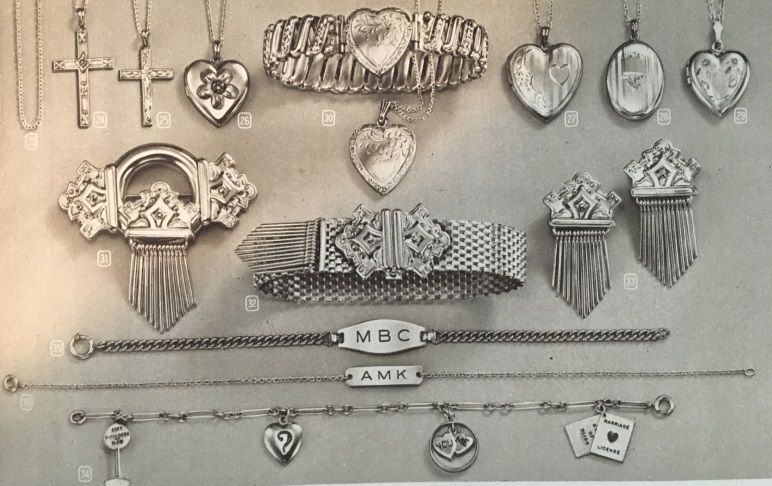
1947 ID bracelets, charm bracelet, stretch band bracelets in gold
Bangles enjoyed a surge in popularity during the late 1930s through to the 1940s. It became the fashion to adorn the arms with a stack of various thick colored plastic, wood or gold bangles .
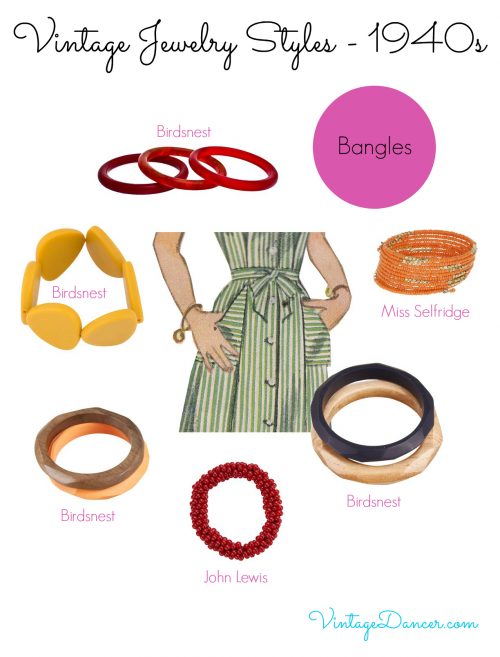
A popular way of incorporating color into an outfit was through the use of bangles(etsy).
As these were made from early plastics, they were often relatively inexpensive to purchase. Therefore, this enabled consumers to buy a whole host of bangles, to wear as many or as few as they wished.
Beaded Necklaces
To finish an outfit or to pick out a particular color, beaded necklaces in bold hues were worn. These necklaces were not worn as long as the previous decade. 1940s necklaces usually rested just above the neckline of clothing or down 16 inches (to mid-chest).
Bead necklaces for daytime could be in a variety of shapes, but many were round beads chained together. Many resembled large pearls (or could be real pearls).
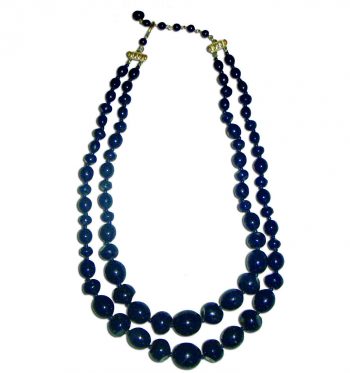
Vintage 1940s blue bead necklace
Beads used for necklaces were usually large. Strands of smaller beads could be braided or rolled together as well. Multiple-stranded bead necklaces were also popular. Beads could be plastic, Lucite, or glass, and were available in any and every color.
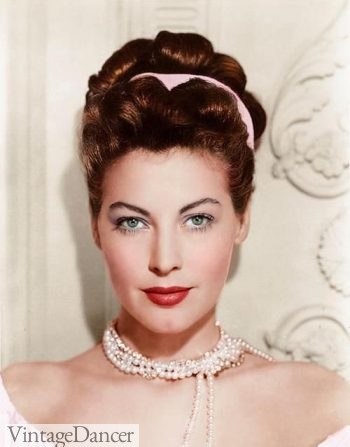
Ava Garden wearing multiple strands of pearls
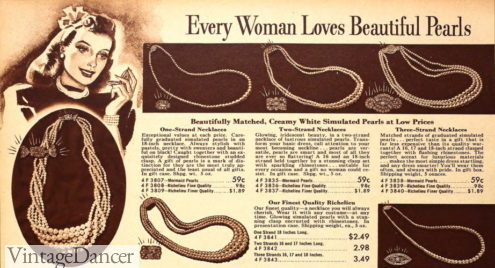
1940 “Every Woman Loves Pearls”
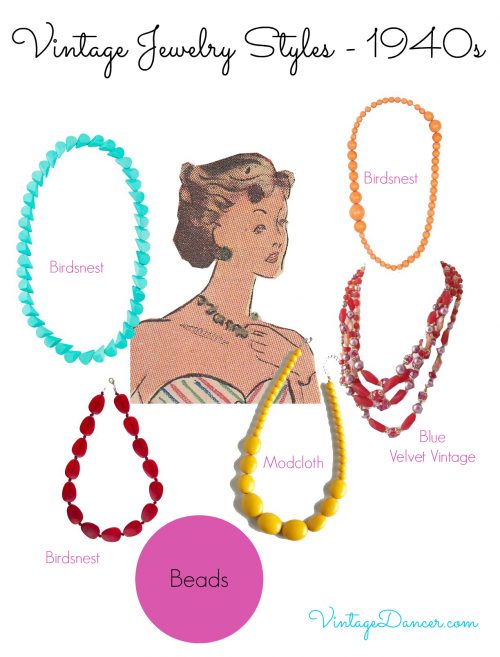
Add a pop of color to your 1940s vintage inspired outfit with a bead necklace.
As costume jewelry designs were getting larger and bolder, so too were the methods on how to display them. Bib necklaces became popular in the late 1940s. This design enabled the focus to be on the center front of the necklace. Matching earrings were also oversized.
Cascades of beads or shapes drew the attention to the neckline. Some of these necklaces featured multiple strands of beads, all situated at differing levels.
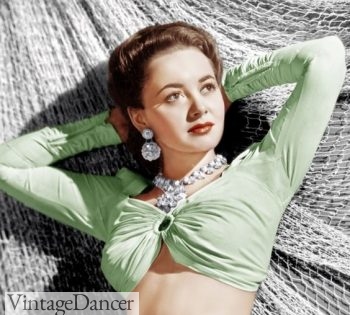
1941- Heavy bib necklace and earring set worn by Olivia de Havilland
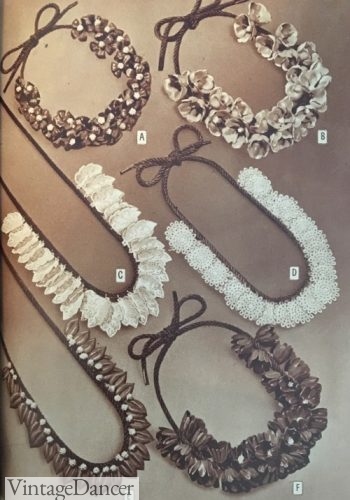
1940s statement flowers necklaces
Gold or silver two picture locket necklaces were usually a girl’s jewelry piece, but with men going off to war, women of all ages wore lockets with their husband’s or sweetheart’s picture in them. Needless to say, heart shapes were the most popular, with round or oval being simple alternatives. Locket brooches were another option. Both styles were also engraved with a woman’s initials on the back and embossed with scroll work or flowers on the front. They hung from long single chain necklaces. Teens also hung a sweetheart’s ring from a chain necklace.
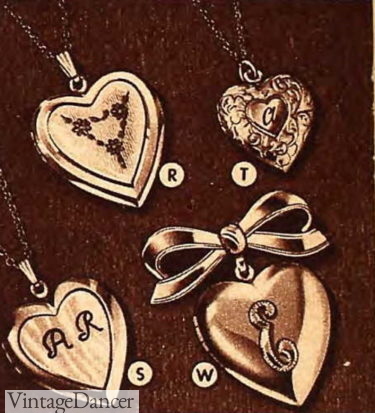
1941 locket necklaces
Earrings
1940s earrings and necklaces or brooches usually came in a matching set. Most earrings were clip on, although post and screw for pierced ears were available. Earrings were large round “button” earrings. They were impossible not to notice with shoulder length hair pulled off the face, exposing the ears. Flowers, bows, and sunbursts made naturally round earrings. Clusters of white or colored gems or a large faux pearl wrapped with a gold ribbon complimented the oversized brooches or statement necklaces for both day and evening looks.

White flowers and bow earrings

1945 earrings
Earrings were not always worn. The general advice was to choose only two pieces of jewelry: earrings and brooch, necklace and hat pin, bracelet and dress clip, etc. Anything more than two was too much for the already big and bold jewelry styles.
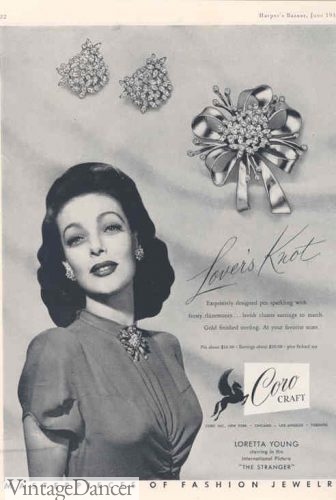
1946 Coro brooch and earring set
Rings, Wedding Rings
As children, gift rings with a birthstone or engraved initials were worn until a girl was married. The gold or platinum bands had a simple center stone cut in a square or oval. These big, bold, colorful gemstones could also be worn as additional rings after marriage, too.
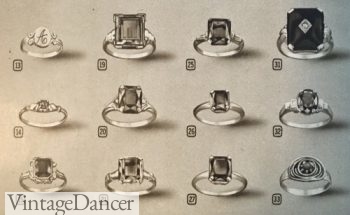
Women’s birthstone or monogram rings
Wedding rings during the war were also very simple. The could be a plain band with some etched design like flowers or a chain of hearts. Slightly more fancy bands had small white gems across the top in a single or double row. The next level of band was a set of two. One band was simple, and the other had a center round diamond or white gemstones. Additional small gems on either side increased the cost of the ring.
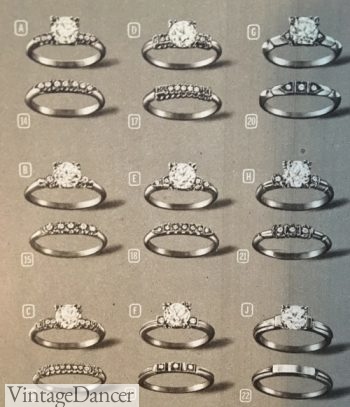
Modest wedding ring sets
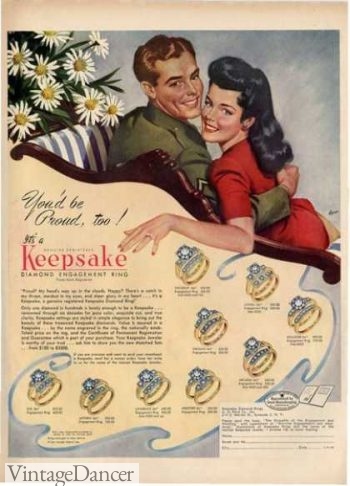
1945 large wedding ring sets
Watches
The final style of jewelry we will look at is a watch. Watches came in two types: wrist or pendent.
Pendent watches have been popular since the Victorian age, yet they lost favor for a few decades after 1910. Since the 1940s experienced a Victorian revival, there was renewed interest in lapel watches. They pinned to a woman’s coat, suit jacket, or other top. They were part watch and part brooch, part jewelry and part utility. Most had small silver square or round faces set in yellow, white or rose gold cases. They hung from big bows, knots, Vs for victory, bars and novelty designs. They were quite small and dainty– young eyes were required!
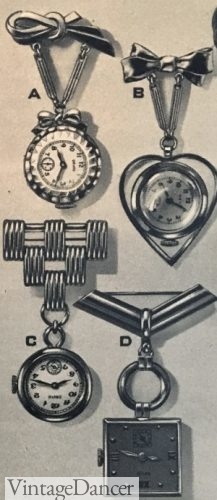
1942 pendent watches
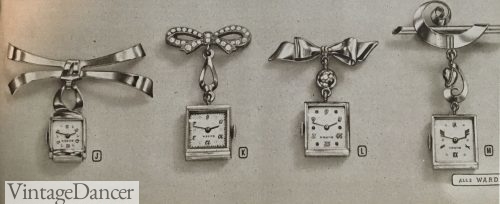
1940s Pendent Watches
Wrist watches were more common than pendents. To conserve on metal, silk cord bands were very popular. They were usually black bands, but some styles for young women came in yellow or pink to match the pink or yellow gold cases. Watch faces were small in round, square, rounded square, heart, and long rectangles. Numbers were printed in black or gold on white or light grey faces. Accents of small diamonds added sparkle to fancier designs. Carved bows, roses, leaves and scrolls accent cheaper models. Most watches were simple shapes with only a little decorative detail added to keep them looking feminine.
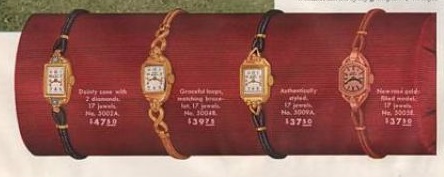
1940s Elgin brand watches
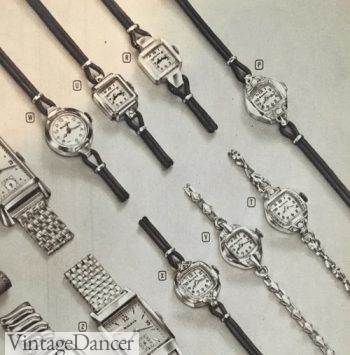
1940s silk cord watches
Bands that were metal came in thin chain link or stretch links in various shades of gold. An active working woman might also choose a simple leather band, but in general, these were worn by men only.
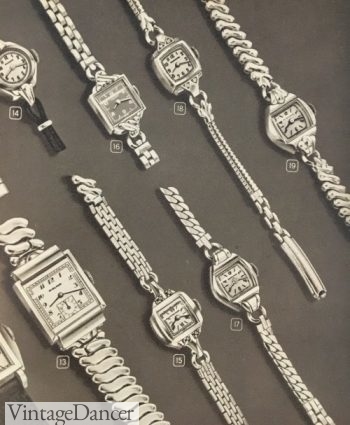
1940s chain link and stretch wrist watches
1940s Jewelry Themes
Patriotic
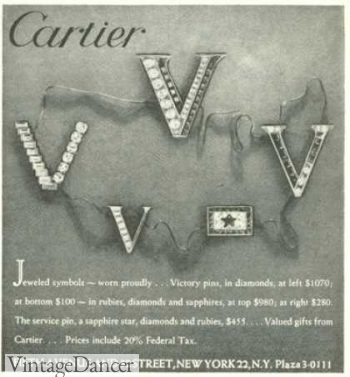
1945 Cartier “V” brooches. V stands for Victory, a common word and symbol during the war
Almost partnering hand-in-hand with the novelty trend was the vogue for patriotic jewelry. Designs of red, white, and blue were popular — however, red alone was often confused with communism, making them slow to sell.
Patriotic themes such as airplanes, propellers, soaring eagles, flags, trumpets, drums, Uncle Sam’s hat, anchors and slogans like “Remember Pearl Harbor” and “Long May it Wave” found their way onto brooches. Young women often wore military insignia pins given to them as presents by their soldier boyfriends stationed overseas. The letter V for Victory was an especially popular brooch.
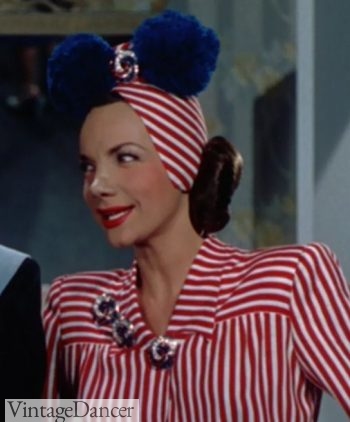
Carmen Miranda wears a set of patriotic pins on her dress and hat in ‘The Gang’s All Here’.
It was extremely important to keep morale up and to keep spirits high. The trend for novelty and patriotic clothing, accessories, and jewelry in some small way helped to do this.
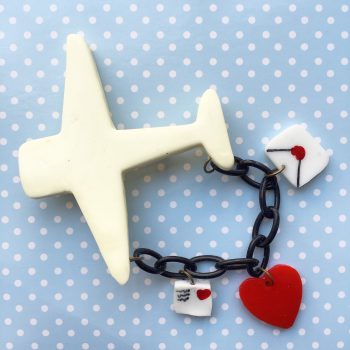
This Airplane pin by Mrs Polly’s Lucite is lovely
Novelty Shapes
The hardships of the decade produced a counter-response in the form of amusing novelty prints and jewelry. As a result of this, many designs were made into novelty pins or brooches. Horses, hands, hats, pencils, and lips were all popular designs. In addition, even pins with jointed movable parts were worn.
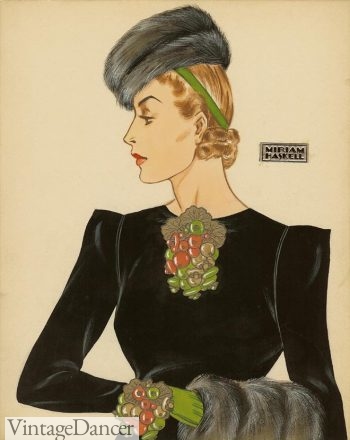
Haskel jewelry ad featuring large clusters of olives
Alfred Philippe, a designer at Trifari, produced animal figures called Jelly Bellies. Elephants, fish, swans, birds, poodles, penguins, lizards were among his favorite collections. They were made of large polished cabochons of Lucite that looked like rock crystal. Coro, an American jewelry brand, and other costume jewelry brands copied his designs, resulting in a lawsuit.
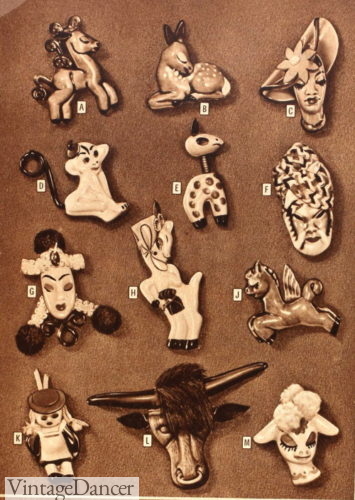
1944 ceramic animal pins
Coro made the famous Duette pin: a large brooch that split into two pieces such as two faces, two birds, or two flowers. They were inspired by Cartier’s early dress clip pairs. The Duette pin could be worn as one on a dress or divided and worn on a dress and hat or hat and coat. Original novelty pieces are now highly collectible, with some selling for incredible prices.
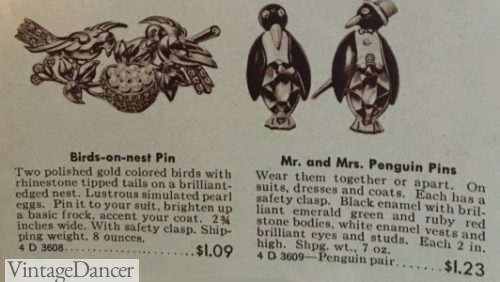
1942, Novelty brooches: Penguins and birds nest
Luckily, a variety of vintage reproduction designs are available, offering just as much wit and whimsy.
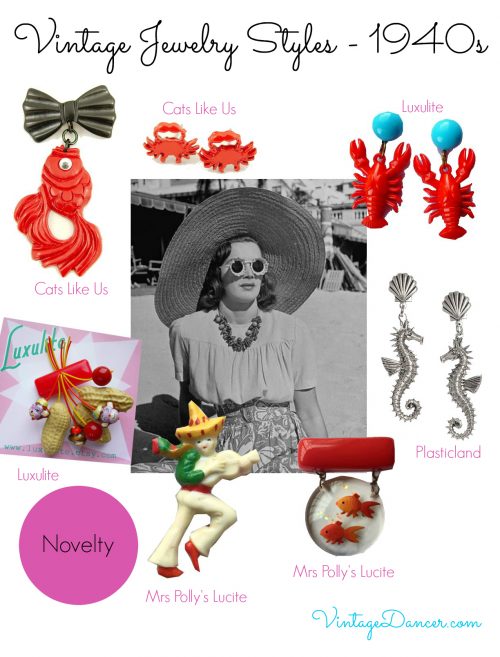
Make your outfit stand out with novelty 1940s inspired jewelry.
Nature Themes
Natural shapes and forms continued in popularity during the 1940s. Feathers, birds, leaves, and insects were all utilized in costume jewelry designs. These designs were often made using glass rhinestones for sparkle at low cost.
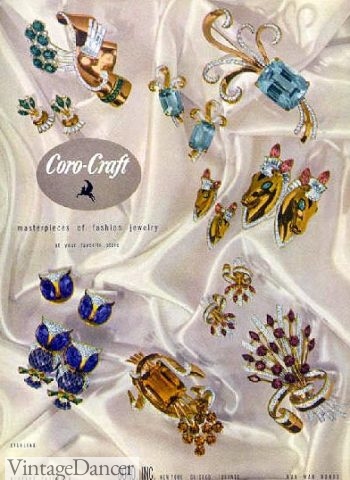
1944 Coro Jewelry of colored flowers, animals, insects
Jonas Eisenberg of Eisenberg and Sons started as a clothing designer, but when his large sparkly brooches were stolen off dresses, he turned to jewelry design instead. They were worn by a number of Hollywood stars. Brooches with bows and big gemstones were the best sellers.
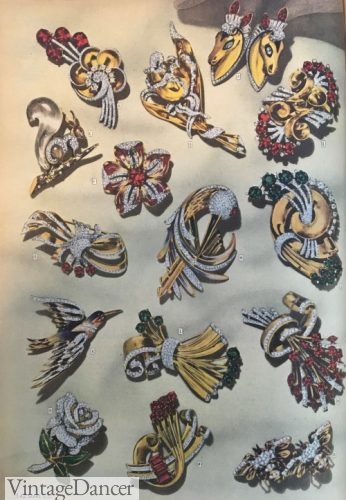
1940s Gold and gem stone brooches: flowers, birds, horses, squirrel, bumble bees
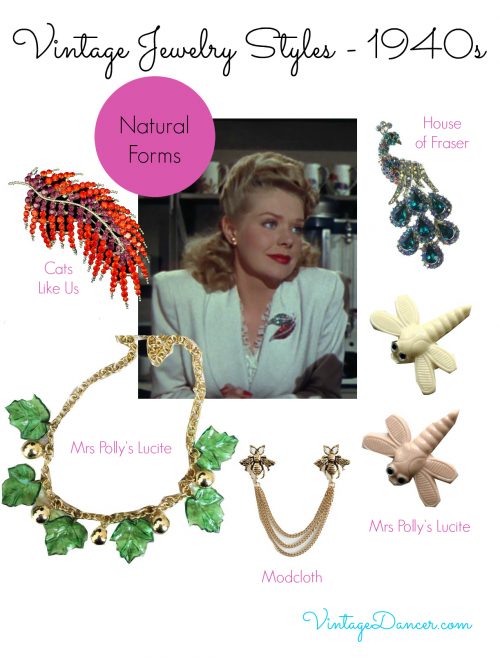
Nature was again a source of inspiration in jewelry design during the 1940s.
Flowers
Botanical shapes have remained a popular choice in jewelry design for centuries. From the late 1930s onwards, floral forms started to become more exuberant.
One of the most noted jewelry designers of this period is Miriam Haskell. Haskell worked with designer Frank Hess up until the 1960s, producing beautiful botanical designs. Her clients and fans included Joan Crawford, Lucille Ball and the Duchess of Windsor.
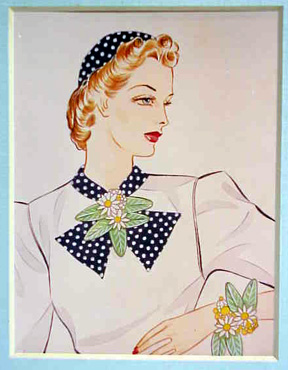
1940s Flower Jewelry brooch and bracelet
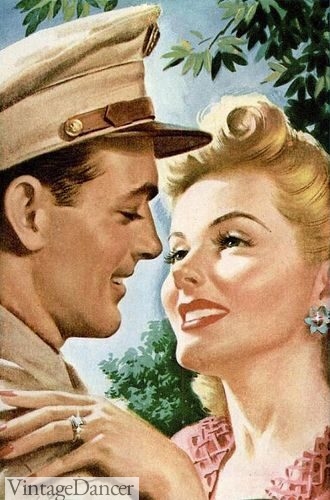
1944, Charming flowers make the perfect earrings
Miriam Haskell pieces are distinguishable by the use of textural layering, bright unusual color combinations, and bold shapes. She had a knack for transforming wood, beads, and shells into jewelry art.
Today, Haskell’s pieces are highly collectible and sought after. However, many vintage reproduction pieces are available which perfectly incorporate the style of the period.
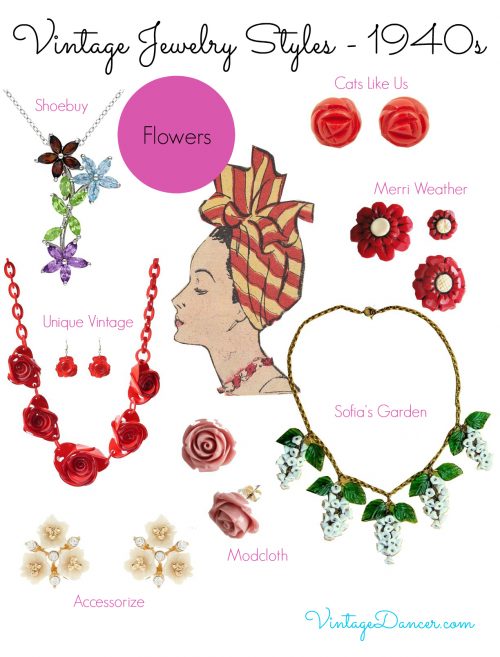
Accessorize your 1940s inspired outfit with these floral jewelry pieces.
Fruit And Vegetables
Alongside flowers, fruits were a fashionable choice for costume jewelry designs. Cherries were among the most popular, but other fruits were also favored. Bananas, pears, grapes, and oranges all featured. Vegetables shapes were also utilized with carrots, sweet corn, and peppers all being employed in designs.
Some of these styles were produced in early plastic, others were carved from wood then painted.
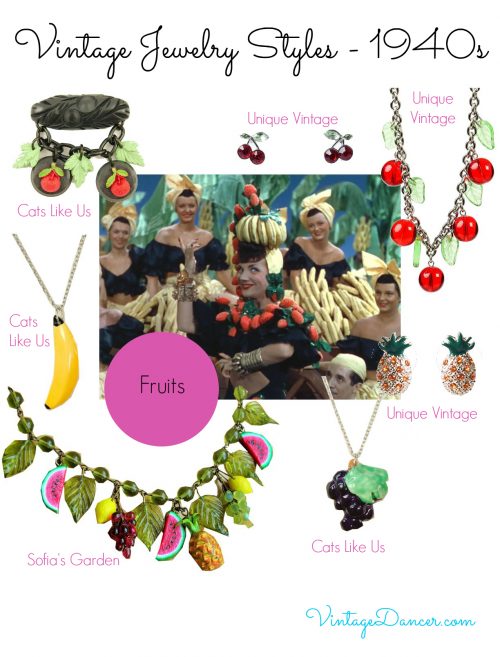
Fruit shapes add a touch of whimsy to your 1940s inspired outfit.
Fruit jewelry was a trade-mark of the singer and movie star Carmen Miranda. Carmen provided much-needed lighthearted entertainment during this decade. She starred in movies such as The Gang’s All Here (1943), Down Argentine Way (1940), and Springtime in the Rockies (1942). Many of Carmen’s costumes were designed and made by herself, and have since become iconic.
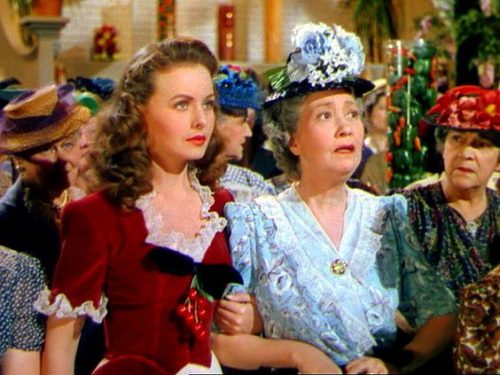
Fruit decoration featuring prominently in the 1945 movie ‘State Fair’.
The MacArthur Heart Pin
The most popular heart pin of the 1940s was the MacArthur key to my heart pin. Made from Bakelite, the pin stood as a symbol. It represented patriotism, hope, unity, and love. The pin gained popularity from being prominently featured on the cover of ‘Life’ magazine in 1941.
Hearts also featured in necklaces and bracelets, often paired with arrows or key designs.
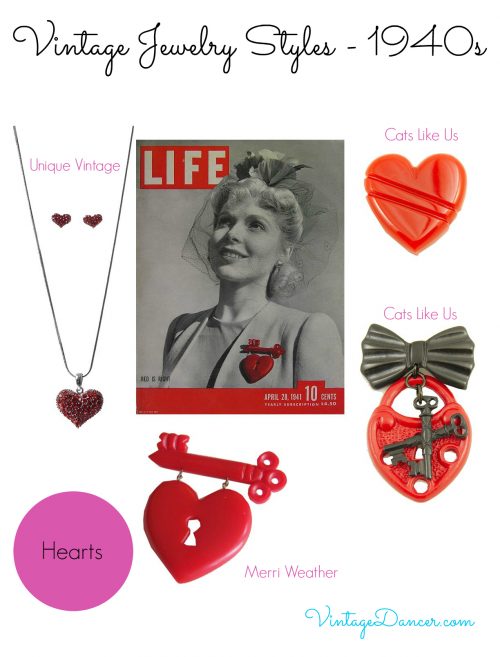
A great selection of vintage inspired heart jewelry available today.
1940s Fashion Jewelry: Evening Styles
In the most formal settings, jewelry stayed with the white on white theme of the 1930s, but grew bigger and heavier. Rhinestones and pearls were especially popular. They could be worn separately but often mixed.
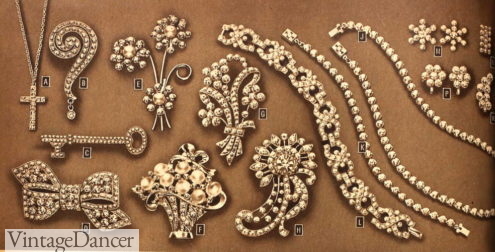
1948 rhinestone jewelry
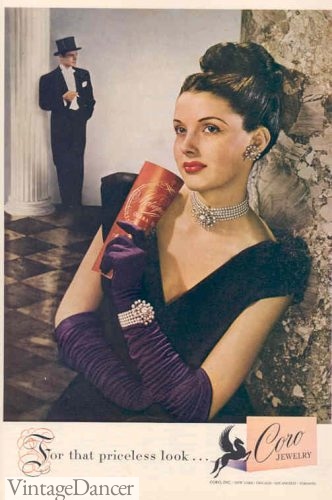
1946, rhinestone and pearl choker necklace and large bracelet. Pearl and rhinestone cluster.
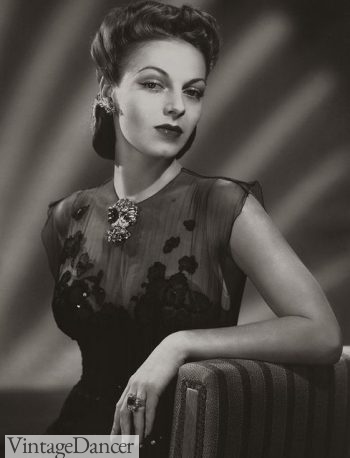
Vera Zorina, 1944 evening jewelry- heavy rhinestone brooch, ring and earrings
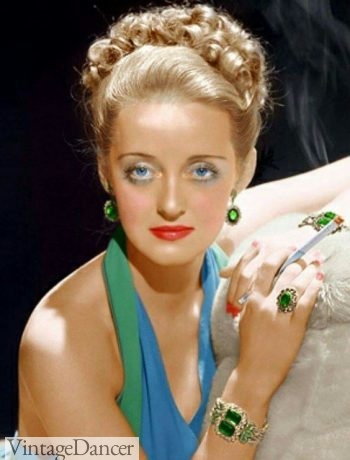
Full color gem jewelry was also common in evening wear in the late 1940s. Bette Davis.
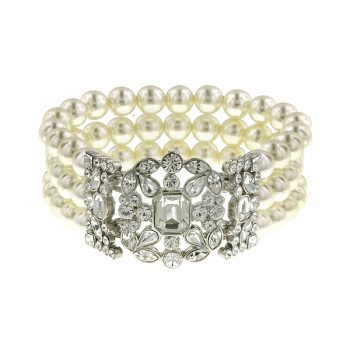
Pearl and rhinestone bracelet. Perfect for 1940s evening wear.
Shop 1940s Style Jewelry:
Tip: 1940s costume jewelry is very plentiful and cheap to buy. For even more affordable options, shop around Christmastime. Many new clothing department stores carry an assortment of costume jewelry that looks 1940s.
